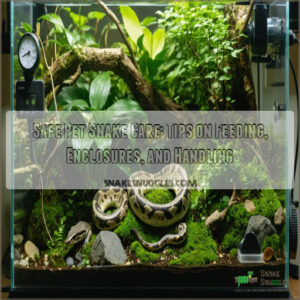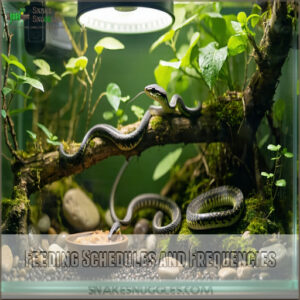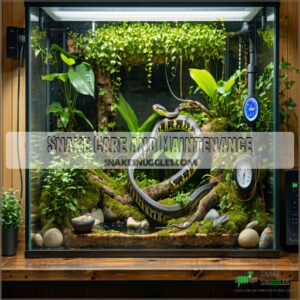This site is supported by our readers. We may earn a commission, at no cost to you, if you purchase through links.

Choose beginner-friendly species like corn or ball pythons that are gentle and manageable. Research local ownership regulations and invest in a proper enclosure with secure lid latches, adequate ventilation, and appropriate substrate depth.
Maintain consistent temperature and humidity levels suited to your snake’s specific needs. Always provide fresh water, clean surroundings, and a diet matching your snake’s nutritional requirements.
Learn safe handling techniques and create a stress-free environment with hiding spots and minimal disturbances. Understanding your snake’s unique behavioral patterns and health signals will help you become a confident, responsible reptile companion.
Table Of Contents
- Key Takeaways
- Choosing Pet Snakes
- Snake Enclosure Setup
- Heating and Lighting Needs
- Feeding Pet Snakes
- Snake Health and Wellness
- Creating a Safe Environment
- Handling and Interacting
- Snake Care and Maintenance
- Long-Term Ownership Costs
- Frequently Asked Questions (FAQs)
- How do you care for a snake as a pet?
- How to keep a snake healthy?
- How do you keep a snake safe?
- Do pet snakes need veterinary care?
- Should you own a pet snake?
- How to keep a pet snake happy?
- What is the safest snake to have as a pet?
- How to take care of a pet snake for beginners?
- What I wish I knew before getting a snake?
- Are pet snakes high maintenance?
- Conclusion
Key Takeaways
- You’ll need to research and choose a beginner-friendly snake species like corn or ball pythons that match your experience level and care capacity, focusing on their temperament, size, and specific habitat requirements.
- You’ll have to create a precise environment with proper temperature gradients, humidity levels, and secure enclosures that mimic the snake’s natural habitat, using thermostats, hygrometers, and appropriate substrate.
- You’ll want to develop safe handling techniques that minimize stress, support the snake’s body correctly, and always supervise interactions, especially with children, to prevent potential injuries or escape.
- You’ll need to commit to ongoing care, including regular veterinary check-ups, consistent feeding schedules, and careful monitoring of your snake’s health, behavior, and environmental conditions to ensure its long-term well-being.
Choosing Pet Snakes
When choosing a pet snake, it’s important to match the species to your experience level and care capacity.
Research their size, temperament, and specific needs to guarantee a safe and enjoyable ownership experience.
This reorganization ensures that the text is logically grouped and visually separated for clarity, with complete concepts presented in separate lines and double new lines used to separate each group.
Researching Snake Species
Before picking a pet snake, immerse yourself in snake research to match their needs with your lifestyle.
Compare species carefully, focusing on size, temperament, and care requirements. Avoid venomous types for safety. A snake species guide can help you explore options.
Understanding the basics of snake care is vital for making an informed decision, including learning about safe pet snakes.
- Study habitat needs
- Check legal ownership rules
- Review breeding methods
- Learn snake identification basics
- Understand diet and behavior
Best Snakes for Beginners
If you’re new to pet snake care, some beginner species are perfect for you.
Corn snakes, ball pythons, and rosy boas are gentle snakes known for their calm temperaments and manageable size.
These small snakes are low-maintenance and forgiving for beginner snake owners still mastering snake care basics.
Their pet suitability makes them ideal for safe snake handling.
Legal Restrictions on Ownership
Snake ownership isn’t just about picking a species—it’s addressing legal considerations too.
Some areas have strict ownership laws, banning venomous snakes or exotic pets outright.
Permit requirements and license fees vary, so check local regulations before committing.
Regulatory compliance guarantees you avoid fines or losing your pet.
Research species bans and permits early to keep your snake adventure stress-free.
Snake Enclosure Setup
How do you create the perfect pet snake enclosure?
Start with durable enclosure materials like glass or plastic for easy cleaning. Guarantee proper ventilation systems to maintain airflow without risking escapes.
Substrate depth matters—use 2-3 inches of aspen shavings or coconut fiber, depending on your snake’s needs. Add decor options like branches and hides for enrichment and security.
Prioritize accessibility features, like sliding doors, for safe handling. A well-thought-out snake habitat design supports your pet’s health and keeps maintenance manageable.
When selecting materials, consider the importance of proper snake enclosure design to guarantee a safe environment, such as those found at snake enclosure.
Heating and Lighting Needs
To keep your snake healthy, you’ll need to provide precise heating and lighting that mimics its natural environment.
Proper temperature gradients and light cycles are essential for regulating their metabolism, digestion, and overall well-being.
Temperature Control Systems
How do you keep your snake comfortable?
Use thermostat options paired with heat sources like a heat lamp, undertank heating pad, or ceramic heater.
Temperature sensors help monitor thermal gradients, ensuring the right climate control.
Maintain a warm basking spot and cooler areas for proper snake temperature control.
A reliable setup avoids overheating and keeps your pet healthy.
Proper heat lamp systems require understanding of heat lamp safety to prevent accidents, which is crucial for heat lamp safety and overall snake temperature control.
Humidity Levels and Maintenance
Maintaining proper snake humidity is non-negotiable for shedding and respiratory health.
Use a hygrometer for accurate readings, and calibrate it regularly. Water bowls boost humidity, but fogging systems or misting schedules may be needed for species like green tree pythons.
Avoid waterlogged substrates to prevent mold. A balanced snake environment guarantees your pet thrives without unnecessary stress.
To create an ideal environment, consider snake enclosure design principles that promote healthy humidity levels and overall well-being.
Lighting Cycles and Equipment
After setting humidity levels, let’s talk snake lighting.
A proper photoperiod control mimics natural day-night cycles.
Use UVB lighting for species needing vitamin D synthesis, while LED options work for ambient light.
Pair lighting fixtures with timer systems for consistency.
Combine a heat lamp with a basking spot to regulate temperature.
Balanced lighting keeps your snake healthy and stress-free.
Providing the right temperature control methods is essential for creating a suitable environment for your pet snake.
Feeding Pet Snakes
Feeding your pet snake isn’t just about dropping food into its enclosure—it requires understanding its specific dietary needs and feeding schedule.
By providing the right prey type and maintaining a consistent routine, you’ll guarantee your snake stays healthy and stress-free.
Dietary Needs and Requirements
Snakes are carnivores needing a varied diet for proper nutrient balance.
Prey items like frozen-thawed rodents or chicks support digestive health, while live feeding risks injury.
Feeding techniques matter—offer appropriately sized prey for easier swallowing.
For added nutrition, sprinkle food supplements like calcium on meals.
Good food choices guarantee your pet snake feeding routine keeps them healthy and thriving.
Feeding Schedules and Frequencies
Feeding schedules hinge on your snake’s species, age, and digestion rates.
Hatchlings often eat smaller prey items every 5-7 days, while adults need larger meals spaced 10-14 days apart.
Monitor feeding times and adjust based on behavior or weight changes, as proper meal sizes matter—too large can be dangerous.
Stay consistent for a healthy snake diet and smooth digestion.
Food Options and Suppliers
Regarding snake diets, your options include frozen prey, live feeders, or pre-killed prey items.
Frozen thawed options are safer and easier to handle, reducing risks during feeding, and balanced snake feeding tips often recommend frozen prey to simplify handling and align with feeding schedules.
Stick to reputable suppliers to guarantee food quality, whether buying frozen prey or live feeders.
Snake Health and Wellness
Keeping your snake healthy means watching for signs of illness like abnormal shedding, weight loss, or respiratory issues.
Regular veterinary check-ups and a clean, well-maintained environment are essential to prevent common health problems and guarantee your pet thrives.
Preserving the health of your pet requires attention to its environment and regular veterinary check-ups.
Common Health Issues and Symptoms
Snake health issues can sneak up if you’re not careful.
Watch for infection signs around the mouth, abnormal shedding, or difficulty breathing—respiratory infections are common.
Here’s a quick checklist:
- Swollen mouth and discharge signal snake diseases like mouth rot.
- Tight skin or cloudy eyes mean skin problems like poor shedding.
- Parasite control is key to avoiding mites and intestinal issues.
Preventative Care and Veterinary Check-ups
Don’t wait for symptoms to strike; take control with preventative care.
Regular health exams by an exotic pet vet help spot hidden issues.
Follow vaccination schedules and seek veterinary advice on parasite control for solid disease prevention.
A healthy snake is a happy snake.
| Task | Frequency | Importance | Benefits |
|---|---|---|---|
| Health Exams | Yearly | Identifies underlying issues early | Longer snake health |
| Parasite Control | Every 6 months | Essential for disease prevention | Reduces illness risk |
| Vaccination Schedules | Vet-specific | Protects against common snake diseases | Strengthened immune system |
| Veterinary Advice | As needed | Guarantees your preventative care approach is successful | Better overall pet health |
The table outlines the importance of regular health exams, parasite control, and following vaccination schedules to ensure the overall well-being of your snake.
It also highlights the benefits of seeking veterinary advice to guarantee a successful preventative care approach.
Recognizing Signs of Illness and Injury
Spotting shifts in your snake’s behavior is key to illness detection.
Watch for these signs:
- Lack of appetite or abnormal weight loss.
- Dysecdysis (trouble shedding skin).
- Labored breathing or discharge from the mouth/nose.
- Unusual inactivity or aggression.
- Skin wounds or lumps requiring veterinary care.
Stay proactive with regular health checks and a trusted snake behavior guide to guarantee pet snake health.
Creating a Safe Environment
Creating a safe environment for your snake starts with choosing the right enclosure and ensuring it meets the species’ specific needs.
Proper security, appropriate hiding spots, and a suitable substrate are critical for keeping your snake healthy and stress-free.
Enclosure Size and Design
A well-designed snake enclosure balances space and functionality.
Match the enclosure size to your snake’s length, aiming for at least half its body length in width, and use sturdy enclosure materials.
Use sturdy enclosure materials and guarantee proper ventilation systems for fresh air.
Incorporate a thoughtful design layout with hiding places and substrate to mimic a natural snake habitat and keep your pet comfortable and stress-free.
Proper enclosure size guidelines, such as rosy boa enclosure requirements, are essential to guarantee the snake’s overall health and well-being.
Escape-Proofing and Security
To guarantee reptile pet safety, invest in secure enclosures with locks and latches designed for snakes.
Proper ventilation security prevents gaps they might force open, use clamps for glass terrariums and don’t forget snake hooks for careful handling.
Always prioritize escape prevention by keeping the snake tank in an escape-proof room, doubling down on snake safety precautions.
Hiding Places and Substrate Options
Snakes thrive with cozy hiding spots.
Hide boxes, rock caves, or plant decor mimic natural shelters and ease stress.
Choose substrate carefully—sand substrate works for some species but avoid it if ingestion risks exist.
Water bowls should be accessible but not overcrowded.
For reptile care basics, prioritize snake hiding behavior; balanced hiding areas create a secure, enriching habitat for happy snakes.
Handling and Interacting
Handling your pet snake safely helps build trust while ensuring its comfort and well-being. By supporting its body properly and avoiding sudden movements, you can promote a stress-free interaction.
Safe Handling Techniques and Tips
Handling snakes safely starts with gentle handling and proper snake support.
Use both hands to cradle its body, avoiding sudden movements.
For larger snakes, safe restraint may require handling tools like hooks.
Injury prevention means staying calm—don’t grab or squeeze.
Always read your snake’s behavior—it communicates discomfort with hissing or curling.
Snake care tips prioritize respect and patience.
Supervising Children and Snake Interaction
When kids and pet snakes mix, adult supervision is a must.
Teach gentle handling while emphasizing snake safety precautions—no grabbing or poking!
Choose kid-friendly snakes like corn snakes or ball pythons for easier interactions.
Child safety tips include maintaining calm environments and short handling sessions to prevent stress.
Snake bite prevention starts with respecting boundaries and supervised, guided interaction every time.
Understanding proper snake handling techniques is essential for a safe and enjoyable experience with pet snakes, which requires respecting boundaries and following supervised interaction guidelines.
Avoiding Stress and Promoting Relaxation
If your snake is stressed, it’s time to focus on creating a calming environment.
Watch for signs like hiding excessively or refusing food.
Follow these steps for snake calming:
- Limit Handling: Give them quiet, hands-off time.
- Environmental Enrichment: Add plants, hides, or branches.
- Relaxation Techniques: Maintain consistent lighting and temperatures.
A relaxed snake is a healthy snake!
Snake Care and Maintenance
Keeping your snake healthy means staying on top of enclosure cleaning, temperature regulation, and humidity control.
By monitoring your pet’s behavior and making small adjustments as needed, you’ll create an ideal environment for their long-term well-being.
Cleaning and Disinfecting Enclosures
Keeping your snake’s space clean isn’t just tidying up—it’s protecting their health.
Start with waste removal daily. Once a week, scrub surfaces with snake-safe disinfectant types and rinse thoroughly.
Focus on sanitation methods like deep-cleaning hides and water bowls. A well-ventilated enclosure improves hygiene practices.
Cleaning enclosures regularly keeps your snake stress-free and their environment healthy for the long haul. Effective snake care requires using proper cleaning supply tools to maintain a clean environment, which is crucial for their well-being.
Maintaining Temperature and Humidity
Precise temperature and humidity are essential for snake care.
Calibrate thermometers regularly and use hygrometers to monitor levels.
- Maintain temperature gradients with heat sources like mats or lamps.
- Verify humidity matches your snake’s needs using moisture control methods.
- Use a dish of water or misting for adjustments.
- Avoid swings in temperature.
- Pair gauges with backups to prevent errors, ensuring accurate humidity control.
Monitoring Snake Behavior and Health
Now that your setup’s under control, pay attention to behavioral signs.
A relaxed snake posture shows comfort, while hiding constantly or refusing food signals stress.
Use a snake behavior guide to track patterns, like feeding response or shedding cycles.
Regular health checks help catch issues early, and staying alert for stress signals or unusual movements is crucial.
Early action guarantees great pet snake health, so it’s essential to be vigilant and responsive to your snake’s needs.
Long-Term Ownership Costs
Owning a pet snake involves more than just the initial purchase price, as you’ll need to budget for ongoing expenses like enclosure maintenance, food, and veterinary care.
Your total annual costs can range from $450 to $1,500, depending on the snake species, so it’s vital to understand the financial commitment before bringing a slithery friend home.
Initial Purchase and Setup Costs
After mastering snake care basics, you’ll want to understand the initial investment.
Pet store prices for snakes range from $20 to $1,000, with popular beginner species like ball pythons or corn snakes costing $50-$500.
Factor in equipment costs: basic enclosures start at $20, while custom terrariums can hit $1,000.
Heating and lighting add another $100-$200 to your snake ownership budget.
Ongoing Expenses and Maintenance
Managing ongoing snake maintenance can drain your wallet faster than a serpent slips through grass.
Budget carefully for recurring snake supplies, vet bills, and replacement equipment.
Food costs, specialized heating elements, and substrate will add up monthly.
Plan ahead by setting aside funds for unexpected snake care expenses to keep your scaly friend healthy and happy with proper snake maintenance.
Planning for Veterinary Care and Emergencies
After budgeting for your snake’s habitat, it’s smart to plan for potential medical surprises.
Find an exotic animal vet who knows reptiles inside and out.
Stash away a few hundred dollars for emergency snake veterinary care.
Build a first aid kit, research nearby clinics with anti-venom, and schedule periodic wellness exams to catch health issues early.
Regular checks for snake health issues can help prevent serious problems, and it is crucial to plan for emergency snake veterinary care and have a vet who knows reptiles.
Frequently Asked Questions (FAQs)
How do you care for a snake as a pet?
An old snake handler once said, "Treat a snake like a delicate dance partner."
You’ll need a proper enclosure, regulated temperature, consistent feeding, minimal handling, and regular veterinary check-ups to keep your slithery friend healthy and thriving.
How to keep a snake healthy?
You’ll keep your snake healthy by maintaining proper habitat temperature, providing clean water, feeding an appropriate diet, scheduling regular vet check-ups, and monitoring its behavior for any signs of illness or stress.
This sentence already groups related ideas together and forms a complete, coherent thought, so no further separation is necessary.
How do you keep a snake safe?
You’ll want to secure your snake’s habitat with escape-proof locks, maintain proper temperature and humidity, handle gently, avoid sudden movements, and always supervise interactions with children or other pets.
Do pet snakes need veterinary care?
With 1 in 3 exotic pet owners skipping vet checkups, you’ll want to prioritize your snake’s health.
Regular veterinary exams catch hidden issues early, ensuring your slithery friend stays healthy and happy throughout its life, which is why these exams are crucial for maintaining your pet’s overall health.
Should you own a pet snake?
You’ll need serious commitment before bringing a snake home. Research specific species’ needs, habitat requirements, and feeding challenges. Assess your lifestyle, space, budget, and comfort level with handling reptiles carefully.
How to keep a pet snake happy?
Slither into your snake’s world!
Maintain ideal habitat temperatures, provide a stress-free enclosure, offer proper nutrition.
Handle gently, and create a consistent routine that makes your scaly friend feel secure and content.
What is the safest snake to have as a pet?
Corn snakes reign supreme as the safest pet snake.
They’re docile, rarely bite, and adapt smoothly to handling.
Their gentle temperament and straightforward care make them the ultimate choice for first-time snake enthusiasts seeking a low-maintenance reptilian buddy.
How to take care of a pet snake for beginners?
You’ll want to research your snake’s specific needs, invest in a proper habitat with correct temperature and humidity.
Handle gently, feed appropriately, and schedule regular vet check-ups.
To guarantee your scaly friend stays healthy and happy, it is essential to follow these steps carefully.
What I wish I knew before getting a snake?
You’ll face higher maintenance than expected, with specialized habitat needs, precise temperature control, and specific feeding requirements that demand more commitment and research than typical pets.
Are pet snakes high maintenance?
You’ll find pet snakes aren’t as high maintenance as you might think.
With proper research, consistent care routines, and basic habitat setup, most snake species require minimal daily attention compared to traditional pets.
Conclusion
Like a well-oiled machine, your journey into safe pet snake care requires precision and dedication.
You’ve learned essential strategies for selecting, housing, and nurturing your scaly companion.
By following these guidelines, you’ll create a thriving environment that supports your snake’s health and happiness.
Remember, safe pet snake care isn’t just about ownership—it’s about building a responsible, compassionate relationship with a fascinating reptilian friend.
Stay informed, patient, and committed to your snake’s well-being.

















